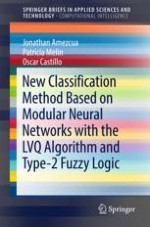2018 | OriginalPaper | Buchkapitel
2. Theory and Background
verfasst von : Jonathan Amezcua, Patricia Melin, Oscar Castillo
Erschienen in: New Classification Method Based on Modular Neural Networks with the LVQ Algorithm and Type-2 Fuzzy Logic
Aktivieren Sie unsere intelligente Suche, um passende Fachinhalte oder Patente zu finden.
Wählen Sie Textabschnitte aus um mit Künstlicher Intelligenz passenden Patente zu finden. powered by
Markieren Sie Textabschnitte, um KI-gestützt weitere passende Inhalte zu finden. powered by
